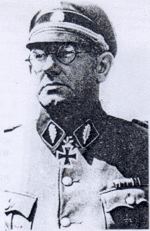Hellmuth Becker
| Hellmuth Becker | |
|---|---|
 | |
| Born |
12 August 1902 Altruppin |
| Died |
28 February 1953 (aged 50) Prison camp No. 337, Sverdlovsk, Soviet Union |
| Allegiance |
|
| Service/ |
|
| Years of service | 1920–45 |
| Rank | SS-Brigadeführer |
| Unit | SS Division Totenkopf |
| Battles/wars | World War II |
| Awards | Knight's Cross of the Iron Cross with Oak Leaves |
Hellmuth Becker (12 August 1902 – 28 February 1953) was a German SS commander during the Nazi era. In World War II, he led the SS Division Totenkopf and was a recipient of the Knight's Cross of the Iron Cross with Oak Leaves. Post-war, Becker was tried by Soviet authorities twice, for war crimes and sabotage, and was executed in 1953.
Career
Born in 1902, Becker joined the army in 1920. In 1933, he joined the SS and met Wilhelm Bittrich and Hermann Priess. In 1935, Becker was transferred to the SS Totenkopf Standarte "Oberbayern", stationed at the SS-Übungslager Dachau, which later became part of the SS Division Totenkopf. Becker was appointed regimental commander in August 1941. In October, he was given command of the division, until March 1944 when he assumed command of the 36th SS Panzer Grenadier Regiment, SS Division Reichsführer-SS in Italy. On 20 July 1944, Becker was given command of the SS Division Totenkopf.
In December 1944, the division was moved to Hungary for the battles around Budapest. The division crossed the Danube River to Vienna, attempting to surrender to the U.S. forces. Under the terms of Germany's capitulation, the surrender was refused and the unit was handed over to the Soviet Red Army.
Trials, convictions and execution
In November 1947, he was put on trial before a Soviet military court in Poltava and sentenced to 25 years forced labor for war crimes. While serving his sentence, Becker "tried his jailers' patience" by attempting to manufacture explosives, leading to his retrial. "The personification of the brutal landknechts who formed the high-ranking officers of the Waffen-SS", he was convicted and executed in February 1953.[1]
Awards
- Iron Cross (1939) 2nd Class (24 May 1940) & 1st Class (26 June 1940)[2]
- German Cross in Gold on 26 September 1942 as SS-Standartenführer in SS-Totenkopf Regiment 3[3]
- Knight's Cross of the Iron Cross with Oak Leaves
- Knight's Cross on 7 September 1943 as SS-Standartenführer and commander of the SS Regiment Theodor Eicke.[4]
- Oak Leaves on 21 September 1944 as SS-Oberführer and commander of the SS Division Totenkopf[4]
See also
- Main article List SS-Brigadeführer
References
Citations
Bibliography
- Parrish, Michael (1996). The Lesser Terror: Soviet State Security, 1939–1953. Praeger Press. ISBN 978-0-275-95113-9.
- Patzwall, Klaus D.; Scherzer, Veit (2001). Das Deutsche Kreuz 1941 – 1945 Geschichte und Inhaber Band II [The German Cross 1941 – 1945 History and Recipients Volume 2] (in German). Norderstedt, Germany: Verlag Klaus D. Patzwall. ISBN 978-3-931533-45-8.
- Scherzer, Veit (2007). Die Ritterkreuzträger 1939–1945 Die Inhaber des Ritterkreuzes des Eisernen Kreuzes 1939 von Heer, Luftwaffe, Kriegsmarine, Waffen-SS, Volkssturm sowie mit Deutschland verbündeter Streitkräfte nach den Unterlagen des Bundesarchives [The Knight's Cross Bearers 1939–1945 The Holders of the Knight's Cross of the Iron Cross 1939 by Army, Air Force, Navy, Waffen-SS, Volkssturm and Allied Forces with Germany According to the Documents of the Federal Archives] (in German). Jena, Germany: Scherzers Militaer-Verlag. ISBN 978-3-938845-17-2.
- Sydnor, Charles W. (1990) [1977]. Soldiers of Destruction: The SS Death's Head Division, 1933–1945. Princeton, N.J.: Princeton University Press. ISBN 978-0-691-00853-0.
- Thomas, Franz (1997). Die Eichenlaubträger 1939–1945 Band 1: A–K [The Oak Leaves Bearers 1939–1945 Volume 1: A–K] (in German). Osnabrück, Germany: Biblio-Verlag. ISBN 978-3-7648-2299-6.